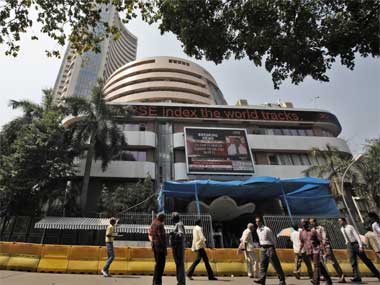The Bombay Stock Exchange’s comatose futures & options (F&O) segment witnessed strong action last week, with traded turnover topping Rs 1,300 crore on Friday. This is the highest single-day turnover in nearly four years, and the renewed interest is mainly due to the stock exchange’s fresh attempt at boosting volumes through cash incentives for derivative traders and brokers to transact on the BSE. Efforts in the past have floundered, and this may well be the exchange’s last stab at trying to carve out a meaningful position in the F&O segment, where it has a negligible presence at the moment.
A few years back, BSE’s plan to whip up F&O volumes through market makers had to be scrapped following allegations of favoritism. (Market markers give both a buy and sell price in usually illiquid financial instruments/commodities, aiming to profit from the difference.)
It will be a while before the BSE can hope to clock even a third of NSE’s average daily turnover (over Rs 1 lakh crore) in the derivatives segment. BSE’s market share in the cash segment is less than one-third of the total turnover, and it has been struggling to retain that.
[caption id=“attachment_130023” align=“alignleft” width=“380” caption=“The Bombay Stock Exchange’s comatose futures & options (F&O) segment witnessed strong action last week, with traded turnover topping Rs 1,300 crore on Friday. Reuters”]
 [/caption]
[/caption]
But it would be a credible achievement if BSE manages to improve its average daily F&O turnover to even Rs 10,000 crore. This is no small target considering that in 2007 - when the market was making new highs - average daily turnover in BSE’s F&O segment did not exceed Rs 2,000.
In financial markets, liquidity feeds on itself, and can trigger both self-fulfilling as well as self-defeating prophecies. Once there is a certain amount of liquidity, traders can move in and out of their positions with ease, which in turn will attract more traders. And the converse is equally true.
It is crucial that BSE succeeds in its attempt to revive its F&O segment, as it will immensely benefit the trading/investing community as well, and improve overall liquidity in the system, besides forcing the market leader to innovate.
And it is not going to be easy, simply because NSE is in a position to match whatever incentives BSE has to offer its community of traders/brokers.
BSE itself is largely to blame for the problems of its F&O segment; successive managements never tried hard enough to generate interest from the broker members. It started from something as simple as a user-friendly interface. The bourse was tin-eared to repeated complaints, and in the process helped NSE march ahead. The BSE has been trying to make amends for the last couple of years.
In its own small way, the exchange has tried to innovate so as to distinguish its F&O offering compared to that of its rival. The BSE tried weekly derivative contracts, and kept a mid-month settlement cycle for its monthly contracts, as against a month-end settlement cycle on the NSE.
But BSE’s most important contribution was providing the option of delivery to F&O traders. What this means is that on settlement day, a holder of a derivative contract can choose to either take delivery or give delivery of shares, depending on his position, if he feels that the price will move in his favour shortly.
How this works is that any position that is not squared off on the settlement day will have to be backed with delivery, just like in the cash market.
Assume that a buyer of 1,000 Bharti Airtel futures (equivalent to 1,000 shares) had initiated his position when the stock price was Rs 350, and on settlement day, the stock price is Rs 300. If he is confident that the stock price will move up shortly, he can choose to take delivery of 1,000 shares.
Similarly, a seller can choose to give delivery of the shares in his portfolio, if the price on the settlement day is higher than the price he had short sold it. On the NSE, the trader has to pay the differential on settlement day, irrespective of whether he has the capacity to take delivery of the shares, or deliver the shares.
Probably, NSE could do well to take a leaf out of BSE’s book. Introduction of delivery in the F&O segment could help check manipulation in many of the illiquid names, and also perhaps encourage retail investors to look at the F&O segment afresh.
The margin of safety is higher if an investor knows that he has the option to take delivery if prices have moved against him
Experts may argue that F&O is not for retail investors. But the counter argument is that the erstwhile ‘badla’ system on the BSE was nothing but a crude version of F&O. And it did have plenty of takers among the retail community.
Coming back to BSE’s F&O segment, participation of institutional investors-especially foreign players-holds the key to its success. Purely incentivising traders will not work beyond a point, because the NSE can always hit back with lower charges and indirect incentives if it feels threatened.
Though liquidity on the NSE is much better in most stocks, institutional players deliberately route a portion of their trades through the BSE. That is because nobody likes a monopoly. If FIIs (foreign institutional investors) and domestic mutual funds were to give all the business to NSE, that exchange could become a near monopoly.
So all is not lost for the BSE; but it has to give institutional players a good reason to get them to trade in its derivative segment. Once liquidity improves to a certain level, it is very likely that institutions will give a portion of their derivatives trades to the BSE. The question is, how will BSE break the deadlock? We will get to know shortly.
Santosh Nair is Editor, Moneycontrol.com. He writes on Banking & Financial Services, Market Outlook - Short Term, Cement & Construction.
)